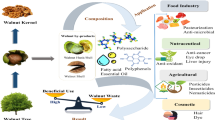Abstract
Polysaccharides were isolated from nopals mucilage pulp and peel of Opuntia Ficus Indica (OFI) and Opuntia litoralis (OL) by aqueous extraction and purified by ultrafiltration. Studying the glycosyl residue composition, these polysaccharides were assumed to be rhamnogalacturonan I (RG-I). The macromolecular features of these compounds have been characterized by SEC/MALLS and by low shear viscosimetry. In the present work, we have undertaken a comparative study about different polysaccharides resulting from OFI and OL growing in different area. This comparison is to see the influence of the geographical area in which these two plants push on the mechanism of retention of water by the different polysaccharides extract. The polysaccharides resulting from the nopal peels of the two plants are highly methylated (>70%), thus they are much more hydrophobic especially for peels of OFI growing in the desert area than those resulting from pulps. Consequently, they probably prevent the evaporation of water in nopals by increasing their water retention capacity. Prickly pear nopals of OFI and OL contain a significant amount of water (>80%), carbohydrates (75% compared to the soluble matter), proteins (8% compared to the soluble matter) and salt (17% compared to the soluble matter). Thus, they represent an important source of water and alimentation especially in the arid and semi-arid areas.




Similar content being viewed by others
References
Intergovernmental Panel on Climate Change (IPCC) Report (Bruxelles, April 2007)
Firew T, Kijora C, Peters KJ (2007) Small Rumin Res 72:157–164
Mizrahi Y, Nerd A, Nobel PS (1997) Hortic Rev 18:291–321
Singh G, Felker P (1998) Indian Farm, 26–31
Barbera G, Inglese P, Pimienta EB (1995) Cultivation and uses of cactus pear. Agro-ecology ed, Rome, pp 215
Pimienta-Barrios E (1994) J Arid Environ 28:1–11
Trachtenberg S, Mayer AM (1981) Phytochemistry 20:2665–2668
Sawaya WN, Khatachadourian HA, Safi WM, Al-Muhamad HM (1983) Food Technol 181:183–193
Uschoa AF, Souza PAS, Zarate RML, Gomes-Filho E, Campos FAP (1998) J Med Biol Res 31:757–763
Forni E, Polesello A, Montefiori D, Maestrelli A (1992) J Chromatog 593:177–183
Forni E, Penci M, Polesello A (1994) Carbohydr Polym 23:231–234
Majdoub H, Roudesli MS, Picton L, Le Cerf D, Muller G, Grisel M (2001) Carbohydr Polym 46:69–79
Majdoub H, Roudesli MS, Deratani A (2001) Polym Int 50:552–560
Habibi Y, Mahrouz M, Vignon MR (2002) Carbohydr Res 337:1593–1598
Habibi Y, Mahrouz M, Vignon MR (2005) Carbohydr Polym 60:319–329
Habibi Y, Mahrouz M, Marais MF, Vignon MR (2004) Carbohydr Res 339:1201–1205
Sepúlveda E, Sáenz C, Aliaga E, Aceituno C (2007) J Arid Environ 68:534–545
Dubois M, Gilles KA, Hamilton JK, Rebers PA, Smith F (1956) Anal Chem 28:350–356
Montreuil J, Spik G, Chosson A, Segard E, Scheppler N (1963) J Pharm Bel 18:529–546
M’sakni NH, Majdoub H, Roudesli MS, Picton L, Le Cerf D, Rihouey C, Morvan C (2006) Eur Polym J 42:786–795
Goubet F, Bourlard T, Girault R, Alexandre C, Vandevelde MC, Morvan C (1995) Carbohydr Polym 27:221–227
Monsoor M, Kalapathy A, Proctor U (2001) J Agric Food Chem 49:2756–2760
Kravtchenko TP, Berth G, Voragen AGI, Pilnik W (1992) Carbohydr Polym 18:253–263
Simon S, Le Cerf D, Picton L, Muller G (2002) Colloid Surf A 203:77–86
Beltran O, Leon De Pinto G, Martinez M, Picton L, Cozic C, Le Cerf D, Muller G (2005) Carbohydr Polym 62:239–244
Beltran O, Leon De Pinto G, Rincon F, Picton L, Cozic C, Le Cerf D, Muller G (2008) Carbohydr Polym 72:88–94
Joly C, Le Cerf D, Chappey C, Langevin D, Muller G (1997) Polym Int 44:497–502
Utraki L, Simha R (1963) J Polym Sci A 1:1089–1095
Kravtchenko T, Voragen A, Pilnik W (1992) Carbohydr Polym 18:17–25
Joye D, Luzio G (2000) Carbohydr Polym 43:337–342
O’neill M, Albersheim P, Darvill A (1990) In Dey PM, Harborne JB (eds) Methods in plant biochemistry, vol 2. Academic Press, London, pp 415
Koubala BB, Kansci G, Mbome LI, Crépeau MJ, Thibault JF, Ralet MC (2008) Food Hydrocoll 28:1345–1351
Happi ET, Robert C, Ronkart S, Wathelet B, Paquot M (2008) Bioresour Technol 99:4346–4351
Acknowledgments
The research reported in this paper was supported by French–Tunisian cooperation (CNRS/DGRST project 05/R12-08). The authors thank Dr C. Morvan for helpful for sugar analysis.
Author information
Authors and Affiliations
Corresponding author
Rights and permissions
About this article
Cite this article
Majdoub, H., Picton, L., Le Cerf, D. et al. Water Retention Capacity of Polysaccharides from Prickly Pear Nopals of Opuntia Ficus Indica and Opuntia Litoralis: Physical–Chemical Approach. J Polym Environ 18, 451–458 (2010). https://doi.org/10.1007/s10924-010-0159-2
Published:
Issue Date:
DOI: https://doi.org/10.1007/s10924-010-0159-2




